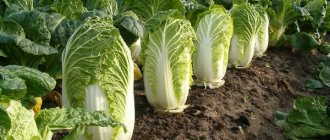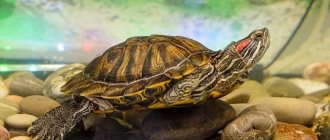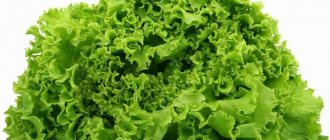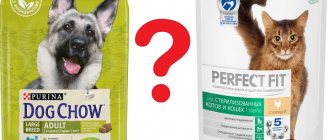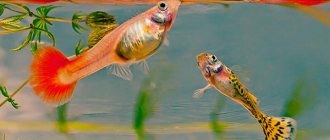Turtles are popular as pets in many countries around the world. Amusing slowness, beautiful patterns on the shell, high life expectancy and ease of care have allowed turtles to remain the most common type of pet among reptiles for many decades.
To keep your pet from getting sick and feeling good, you need to properly plan its diet. This is especially important for beginning turtle breeders. Before deciding to buy a pet, you need to find out what turtles eat at home.
Types of turtles
Herbivores
This large group of reptiles needs food of plant origin. Meat can be added to the feed in very small quantities, and the basis of the diet is vegetables, fruits and grass. The most common types of turtles used as pets are Central Asian and Mediterranean turtles.
Predatory
These reptiles eat meat, plant food serves as a snack and does not exceed 10% of the volume of food consumed. They need to be given seafood and lean fish as food. Almost all aquatic turtles are predators.
Most popular:
- Trionix;
- swamp;
- red-eared
The last two species feed on fish only at an early age. Adult turtles switch to mixed types of food.
Omnivores
Their diet consists of plants and meat in approximately a 1:1 ratio. Due to evolutionary features, this group most often includes land reptiles, as well as red-legged, adult red-eared and marsh reptiles.
Where did the turtle come from?
The turtle is one of the most ancient reptiles, born more than 220 million years ago.
Nowadays, these ancient exotic animals are represented by more than three hundred species. They live both on land and in water - turtles are either sea or freshwater. They live wherever it is warm, from the tropical seas of the southern continents to the steppes of Eurasia and North America. The variety of sizes of turtles is also amazing - from huge leatherback sea turtles, which are 2.5 m in length and have the same flipper span with a body weight of up to a ton, to musk turtles with a shell of less than 20 cm. Yes, there are smaller turtles - males Cape spotted turtles have a dorsal shield (the upper half of the shell) less than 10 cm. The largest turtles did not survive to our era: the ancient Archelons were 4.5 m long and weighed over two tons. Now smaller specimens live on land - elephant turtles with a body length of two meters and a weight of about 400 kg.
European sailors first became acquainted with giant turtles when the squadron of the later famous Christopher Columbus discovered Cuba and Jamaica. A meeting with sea turtles of amazing size is colorfully described in one of the sources, when sailors mistook the turtles for underwater reefs - there were so many unusually large, huge-sized turtles that they littered the entire bottom, the shells of the moving animals even slowed down the progress of the ships along lagoon.
This historical acquaintance was not in vain for the giant turtles - because. These animals have tasty meat and they are unpretentious in the absence of food for a long time, including in less than suitable conditions, and thanks to these qualities they began to be used as canned live food. The caught turtles were placed in the holds of ships and, as needed, taken out - alive - and used for culinary purposes. The sailors' menu was not varied, and anyone could get tired of the corned beef and crackers. At that time there were no canned food, which were invented much later, nor, especially, refrigerators and freezers. The meager menu of seafarers was diversified only by freshly caught fish. So fresh turtle meat came to the table! Such curious features of turtles eventually led to the fact that large turtles began to be intensively caught and it almost came to complete extermination. Currently, 228 species of turtles out of more than three hundred are included in the Red Book of the International Union for Conservation of Animals.
Nutrition of aquatic turtles
Fish and seafood
Aquatic turtles need a lot of animal food. Most often they are fed with low-fat river fish.
The following types are suitable:
- hake;
- pollock;
- perch;
- cod;
- navaga.
What do sea turtles eat? The same as their freshwater counterparts. They can feed on any type of fish, unlike freshwater reptiles. Lake turtles do not eat marine fish.
Small fish can be given whole; large pieces are recommended to be cut into small cubes. Young animals should be fed in very small pieces, after removing all fish bones.
Meat
The meat they feed is beef, chicken or fish liver - given as a treat no more than once a week. You can feed small animals: frogs, mice, rats are suitable. It is strictly forbidden to feed pork and veal, as well as meat products - sausages and minced meat.
The diet also includes insects and crustaceans (daphnia, hamarus, bloodworms, cockroaches, earthworms) and snails (small ones are fed whole, large ones - only without the shell). Shellfish such as mussels and oysters are also edible.
Plant food
Aquatic turtles eat vegetables, greens - lettuce and cabbage, and occasionally fruits (mainly apples). Plants serve not so much as food, but as a source of vitamins and microelements. In addition to plant foods, reptiles can be given mineral supplements - the dosage should be determined by a veterinarian.
Nutrition of land species
Authorized Products
Land turtles eat mainly plant foods at home. The main component of the diet is fresh greens: lettuce, white cabbage, dandelion leaves, grass - plantain, sorrel, coltsfoot, clover, sprouted oats.
The most common vegetables that turtles are given are zucchini, tomatoes, cucumbers, carrots, bell peppers, beets, and pumpkin. From fruits, you can feed land reptiles with bananas, apples, mangoes, peaches, plums, pears, melons, and a variety of citrus fruits (oranges, tangerines). The berries most loved by reptiles are: watermelon, wild strawberries, strawberries, raspberries, blueberries.
Sometimes you can add animal products (snails, slugs) to the menu - no more than once a month. A hard-boiled egg is fed once a week at an accelerated rate of development of the reptile in its youth. Occasionally it is recommended to pamper your pets with bran, low-fat sunflower seeds, dry seaweed, and dried champignons. Aquarium moss is especially valuable for feeding miniature species.
Feeding rules
Domestic young animals are weaker than their wild counterparts, so they need to be fed once a day. It is advisable for adults to give food once every two days. All turtles are diurnal animals, so they are not adapted to feeding at night. They need to be fed only during the day, preferably in the late morning or at noon.
Greens and vegetables should be exclusively raw - thermally processed food is useless for the body of reptiles. It is not recommended to give meat food too often - this can disrupt the metabolism of land turtles.
Approximate diet
Turtles' nutrition should be complete and balanced.
A sample diet includes:
- greens – about 75-85% of the menu;
- vegetables – up to 15%;
- fruits – 3-4%;
- dried treats – 1%.
Features of feeding in winter
What to feed a turtle in winter? Many people are concerned about this issue, because it is not always possible to buy fresh herbs in large quantities in the midst of cold weather. In this case, the pet can eat hay and vegetables soaked in water. The physiology of reptiles must also be taken into account. Turtles already have a very slow metabolism; in the cold season this feature becomes even more noticeable. It is very important to maintain the temperature and provide the reptile with ultraviolet light.
Some turtles can hibernate, and not just in winter. Summer hibernation is observed during a period of drought - the cold-blooded animal senses a change in the weather and reacts to it, even living in a terrarium. During suspended animation, the reptile spends almost no energy, so it does not need food. The main thing at this time is to maintain the lighting with a UV lamp so that the body continues to synthesize the necessary vitamins.
Prohibited Products
Some foods are dangerous to the health of turtles. They can cause metabolic disorders, various diseases and even death. To protect your pet from problems with the digestive system, it is strictly forbidden to feed reptiles with dangerous foods.
These include:
- insects (cockroaches and crickets);
- spicy vegetables (onions, garlic);
- any meat and products made from it (sausage, minced meat);
- bread;
- dairy products;
- cereals (except for rolled oats flakes);
- citrus peel;
- pits of cherries, plums and apricots - they contain hydrocyanic acid.
Do land turtles need water?
These reptiles, like other animals, require water for normal functioning. In nature, they get it from the stems and roots of plants, and also drink it when swimming in ponds.
There is no need to install special drinking bowls for a domestic reptile, but regular bathing should be organized. For some species, weekly water procedures are needed, for others it is enough to carry them out once a month. But it is still optimal to bathe pets once a week, and even more often in the hot season.
It is enough to pour warm water into a small container, not lower than +25 °C, and lower the pet there so that the liquid covers the entire upper shell and reaches at least the middle of the neck.
Diet of omnivorous species
Diet of cubs
What can you feed the young animals? Few owners know that the diet of cubs is very different from that of adults. Young turtles are actively growing, so they need frequent feeding - at least once a day. They must receive a balanced diet with plenty of vitamin D for bone growth and proper shell development. Young animals need meat more than adults. Their diet combines those of carnivorous and omnivorous species.
Land omnivores prefer snails, slugs and vertebrates for meat - mice, frogs, rats. Aquatic omnivores have a greater need for fish and seafood.
Adult meals
A mature turtle eats very rarely - only two to three times a week. They grow slowly or not at all, so they do not require large amounts of vitamin D. Adult turtles are fed vegetables and greens: plants account for 60% of their food intake.
There are features depending on the reptile’s way of life:
- Land turtles eat grass, vegetables and fruits. The basis of the plant part of the diet is lettuce, cabbage and dandelion leaves.
- Aquatic representatives prefer algae (especially seaweed) and aquatic vegetation. Many of the plants can pose a danger to the health of the turtle, so only a specialist can name absolutely safe algae for a particular species.
Ready-made feed
With a constant lack of time in the modern world, people are forced to buy ready-made food for their pets. Sometimes this method also saves effort - you don’t need to prepare the mixture yourself. Below are the main types of commercial turtle food.
Overview of store options
Arcadia Herbi mix
The food is based on plant components with the addition of pollen. It is rich in mineral and vitamin supplements. Suitable only for land turtles.
Sera Raffy Vital
The food is intended for omnivorous turtles. Contains grain (wheat and oats), dried vegetables, fish and its processed products. Enriched with vitamins A, D and B.
Zoomir Tortila granules
The food is suitable mainly for omnivorous mature turtles. Ingredients: alfalfa, vetch, dandelion, berries, carrots, small crustaceans.
Zomir Tortila Fito
The composition includes alfalfa, vetch, dandelion, nettle, cereal seeds, apples, carrots, lingonberry leaves, and a vitamin and mineral complex. Suitable for herbivorous species.
There are almost no prepared foods for carnivorous turtles, since the animals need fresh food and not processed products (for example, fishmeal). The owners of these animals are strongly recommended to feed the reptiles fresh, chilled fish.
DIY food
Herbivorous turtles, like carnivorous ones, rarely have their food prepared. In the first case, it is enough to simply cut the vegetables and put greens in the feeder; in the second, chop the fish and seafood. Therefore, omnivorous aquatic turtles most often need prepared food.
The universal recipe includes:
- cabbage – 50 grams;
- carrots – 70 grams;
- apples – 50 grams;
- squid fillet – 100 grams;
- any lean fish – 145 grams.
All components must be mixed, passed through a meat grinder and a gelatin solution (10 grams per 50 milliliters of water) added. The cooled mixture must be dripped with a mineral additive in the amount specified in the instructions. Cut the resulting “jellied meat” into small cubes.
This recipe is suitable for a small omnivorous turtle - with a shell about 15 centimeters in diameter. The red-eared turtle will especially appreciate this recipe.
Feeding errors
Overfeeding
Reptiles have the slowest metabolisms in the animal kingdom and therefore require little energy. Overfeeding disrupts the metabolism in the body of turtles, and obesity can be deadly because it disrupts the functioning of many systems: endocrine, digestive, and excretory.
Sometimes the accumulation of subcutaneous fat can cause curvature of the shell. This is especially true for very young cubs.
It is important not to go to the other extreme and not starve your pet. It is not uncommon for pet turtles to suffer from malnutrition because their owners did not calculate the required amount of food.
Vitamin abuse
Vitamin D in large quantities is deadly to land turtles. Any supplements should be introduced into the diet only on the recommendation of a veterinarian.
Mineral compounds, such as calcium and magnesium, are no less dangerous. Excess calcium can lead to disruption of the musculoskeletal system of turtles. Pets should be given medications strictly according to the instructions.
Non-compliance with the regime
These animals need to be fed systematically, at the same time. Long breaks in nutrition can cause a shock reaction in the body. Uneven food intake causes many problems in the digestive tract, sometimes leading to the death of the reptile.
Symptoms of improper feeding
Sometimes you can indirectly understand that feeding is being done incorrectly. This is noticeable in the appearance of the animal.
Signs of poor nutrition include:
- obesity or wasting;
- disorders of the gastrointestinal tract;
- change in color of the skin and shell;
- conjunctivitis and rhinitis resulting from a lack of vitamins;
- apathy and difficulty moving the animal.
If any of these symptoms are noticed, you should take your pet to see a veterinarian.
Features of feeding
Swamp turtles are very smart creatures. Their intelligence is significantly higher than that of land animals. They are trainable. It is very easy to teach your reptile to take food from tweezers. If you give her food with tweezers, she will pull her head out of the water and grab the food. She will also accept food when she is outside the water. At the same time, it will go to swallow it into the water. With this feeding, the water in the aquarium will remain clean.
With proper care of the reptile, it will develop a conditioned reflex when the owner appears. She'll pull her head out of the water when she sees him. You can train her to a certain time. Then she will recognize the owner and crawl out to meet him.
The bog turtle has a good appetite. She can only eat in water. She loves hunting, so she will not refuse whole insects and live fish. The animal will happily tear the food apart with its claws and eat it.
If you throw food into water, it will quickly become dirty and spoil. When feeding, it is better to transplant the aquatic resident into a shallow basin of water. In order for food to be well absorbed in the amphibian’s stomach, the temperature of the water in the basin should be within 32-34 degrees. When the turtle is full and wants to leave the water space, it should be transplanted to land.
If a marsh turtle has become inactive and refuses to eat, it should be taken to a veterinarian so that he can examine it and make recommendations.
Additional recommendations
Taking into account the seasons
All turtle species experience a slowdown in metabolism in winter. In the cold season, they need to be fed one and a half times less often than in summer. If a reptile hibernates, it ceases to need food. In summer, the turtle should consume more succulent food (greens, fruits or fish, depending on the type of food). Also in summer an increased amount of vitamins and microelements is required.
Drinking regime
All turtles cannot drink water. They get liquid from food. Therefore, the diet of land reptiles should include a large amount of vegetables and herbs. You can feed an aquatic turtle in an aquarium by simply throwing food into the water - this way the animal consumes the required amount of moisture.
In extreme heat, you can bathe land turtles in a basin. This way the animal will receive moisture and restore water metabolism in the body.
You need to carefully monitor your pet's bathing. The water should not reach the level of the nostrils!
What not to feed turtles
There are general principles: “vegetarians” should not be given meat, and carnivorous species will develop digestive problems if they eat plants. At home, river turtles eat only freshwater fish—sea fish negatively affects their health.
However, there are products that are harmful to all types of turtles:
- Plants of the nightshade and buttercup families are poisonous to almost all animals.
- Indoor plants – dieffenbachia, azalea, daffodils, crocuses, mistletoe.
- Citrus zest.
- Potato tops.
- Seeds of fruits and berries (plums, cherries, cherries).
- Food (dry and jelly) for warm-blooded animals.
- Bread, dairy products, cereals.
- Salted, smoked, fried and other types of dishes not intended for animals.
It is important to closely monitor your pet during a walk so that he does not eat anything harmful.
People and turtles: uses for food, medicine, teaching aids and decoration
Capturing turtles for food
Previously, turtles were widely used as food, as a result of which huge herds and populations of these reptiles greatly decreased and even found themselves on the verge of extinction.
On land, they ate land and freshwater turtles, which were easy to catch and could survive for a long time without food. Residents of the coast and islands, as well as sailors, caught and used sea turtles for food. They were caught both at sea with nets and on land while laying eggs. It was easy to catch and turn over the unfortunate animals. Sea turtles were a very valuable source of food for sailors; they could go long periods of time without eating and were incredibly resilient. Turtles were transported on ships, both alive and dried. Turtle eggs were also eaten. Depending on what the sea turtle ate (plant or animal food), the taste of its meat differed. Unfortunately, turtles and their eggs are still eaten, despite protective measures. But now the turtle dish is considered a delicacy. The situation is worst in Asian countries, where many endangered (and even considered extinct) turtle species have been found in ordinary food markets.
In addition to humans, dinosaurs (ichthyosaurs) fed on turtles, and predatory mammals and birds feed on them.
Turtle soup is a recognized and expensive delicacy. For its preparation, the meat of exclusively Green or Soup turtle (Chelonia mydas), which lives in the southern seas, is used. But since it is not easy to get this turtle, because its population is not so large, and you can’t buy it everywhere, people use any turtles indiscriminately, not realizing that the meat of many is not only not tasty, but can even be poisonous. A bowl of turtle soup costs about $150, and the soup is often made from already dead turtles.
“The fact is that England practically does not have its own national cuisine, and at receptions of such a high level even the menu is in French. In honor of Putin, they served: turtle soup with truffles, salmon medallion in mussel sauce, chicken in champagne, sautéed eggplant, apple salad, peas, cherry parfait. The knives and forks on the table were made of gold, the porcelain was with royal monograms.” “Turtle soup has become synonymous with gourmet food, very expensive and with a hint of slight cynicism, which appears when you realize that a person is not the owner, but mainly the consumer of everything that grows and moves.” “...the contraband cargo was intended for Chinese restaurants in Moscow. A bowl of turtle soup in such establishments costs about $30, so these reptiles are of considerable value.”
Not only soup is made from turtles, but also roasts, stews and other dishes.
Moscow restaurants also serve turtle dishes, although they do not indicate which species: Restaurant PEKIN (BEIJING) 60, SADOVAYA STR. TEL: 310 1141 business-lunch 12.00-15.00 Upscale restaurant. Chefs from Beijing and Manchuria. On the menu: Peking duck, and exotic dishes of turtle and snake. Banquet rooms with karaoke.
Use of turtles for medicinal purposes
Traditional Chinese medicine buys and uses even very rare species of turtles in the production of medicines.
Uzbekistan: Medicine from the blood of steppe turtles will extend human life to a hundred years Fergana.Ru The medicine tortesin from the blood of steppe turtles, created at the Institute of Biochemistry of the Academy of Sciences of Uzbekistan, is designed to cope with the consequences of radiation exposure, for example, among participants in the liquidation of the Chernobyl nuclear power plant accident or among cancer patients who have undergone intensive radiation therapy. Its action stimulates the immune system and normal production of blood cells. According to the author of the development, Candidate of Biological Sciences Vitaly Alexandrov, substances contained in the blood of reptiles, known for their longevity, can in the future be used to extend ordinary human life to at least a hundred years. The scientist came to this sensational conclusion, reminiscent of the plots of science fiction novels, after a series of experiments on laboratory animals. True, things have not yet come to experiments with the “elixir of immortality”. However, according to all the laws of the genre, the researcher did not forget to take care in advance about the fate of the slow donors themselves, patenting a humane method for obtaining the blood of turtles without killing them. According to his method, a sufficient amount of water or saline solution must first be injected into the reptile's body, after which up to two milliliters of blood can be taken from the femoral vein, and then the turtle can be released back into the steppe. DPRK scientists have developed a method for quickly growing “medicinal” turtles PYONGYANG, March 18, /Corr. ITAR-TASS Dmitry Chichin/. Employees of the Zoological Institute of the DPRK Academy of Sciences have successfully completed research on the accelerated cultivation of aquatic turtles, known for their healing properties, KCNA news agency reports. It is believed that the meat of these amphibians helps with chronic fatigue and circulatory problems. Thanks to the efforts of researchers, the exotic “medicine” will now become much more accessible to the country’s population. A special food developed by Korean scientists can reduce by a quarter the time it takes for a turtle to gain maximum weight. In addition, scientists managed to reduce the incubation period of eggs by more than 10 days. At the same time, the institute’s staff also developed methods for monitoring the sex of populations. As a result, scientists were able to increase the number of males, whose meat is most valuable, in the proportions they needed.
Using turtles as teaching aids
It turns out that there are companies that import thousands of swamp turtles from the south of Russia (Crimea), then in cities (particularly in Moscow) they kill them, fill them with formaldehyde and send them to schools as a teaching aid! When most educational institutions have switched to using dummies, these fellows are still living in the stone age and killing reptiles for the entertainment of children. Only the use of turtles for scientific purposes (in museums) is justified, and even then after their natural death in a foster home or in a zoo with the subsequent transfer of the corpse to a museum to create a stuffed animal!
“Natural history and school”Address: Moscow, 107150, Permskaya st., vl. 11, p. 1 website prirodovedenie swamp turtle(495) 160-2310 (495) 981-2932 (495) 160-24-10
"JSC Medius" Address: 191040, St. Petersburg, st. Kolomenskaya 4″A” website medius (812) 764-12-54 director (812) 764-54-94 marketing
“Catching land turtles does not require any equipment. Aquatic turtles are caught when they come onto land, and more often and more successfully - with nets or small fishing nets in the water. Abundant prey is brought by places where reptiles gather for the winter, but the discovery of these places is associated with significant difficulties and largely depends on luck. ... The vast majority of amphibians and reptiles are preserved in alcohol or; as a last resort; in formaldehyde, where he is immersed alive. For better preservation of the internal organs, a small incision is made in the wall of the abdominal cavity, after killing the animal, and for large individuals, a preservative liquid is specially injected into the abdominal cavity. Reptiles are especially susceptible to rotting and it is necessary to cut their belly; The turtles are cut on both sides between the neck and front legs. ... Turtles, especially large snakes and monitor lizards, sometimes have to be skinned and stuffed. The technique for preparing the latter is not fundamentally different from that for animals and birds (see below). The skull must be preserved. In turtles, at the beginning of dissection, the dorsal and abdominal shields are separated, but one cannot limit oneself to preserving only the shields, as is often done. The most practical way to kill turtles is by immersing them in boiling water for a few seconds.”
Using turtles as decoration
Before the invention of plastic, sea turtle shells were used to make combs, jewelry boxes, and hairpins. But since plastic turned out to be cheaper, easier to process, and more varied in color and characteristics, turtles were almost no longer used for these purposes.
